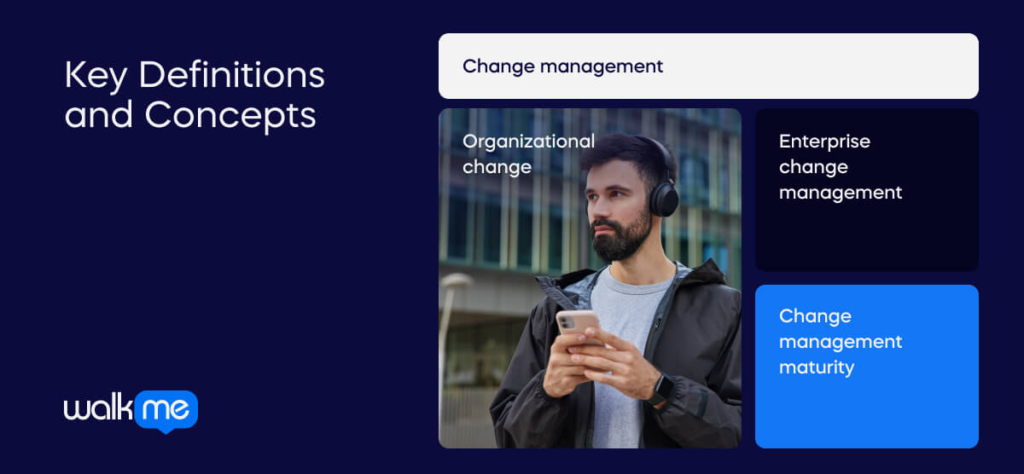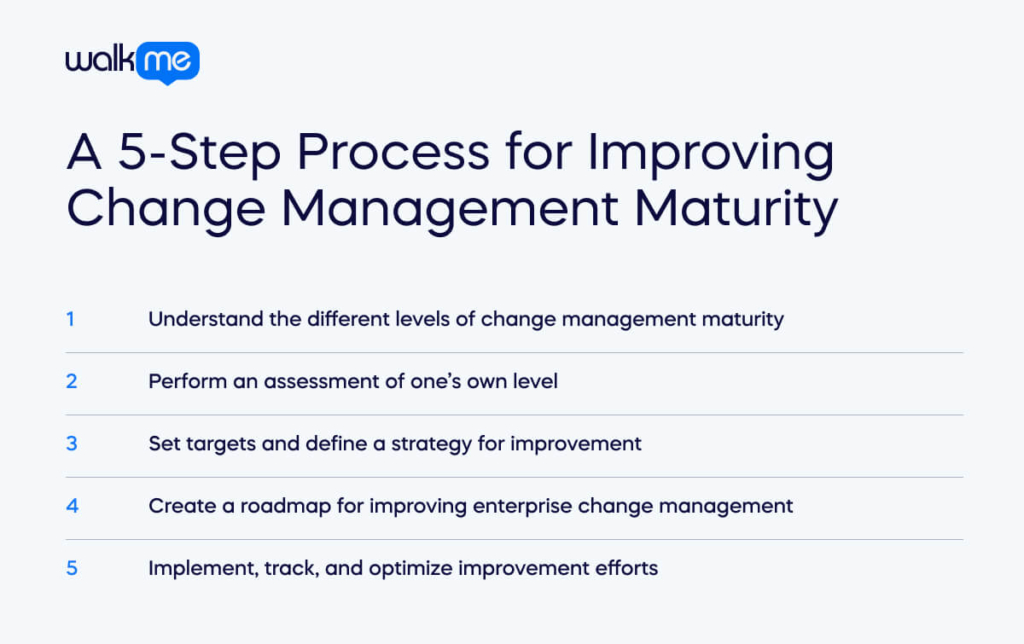A change management maturity level refers to an organization’s ability to implement and manage organizational change.
This capability, also known as enterprise change management, has a significant impact on the efficiency, the effectiveness, and the outcomes of change projects.
Below, we’ll learn how to assign a maturity level to enterprise change management, why such a measurement is important, and how to set about improving it.
Change Management Maturity: Key Definitions and Concepts

Let’s set the context by defining the most essential concepts related to change management maturity:
- Organizational change. An organizational change is a deliberate business project that alters the business in some way. These initiatives are typically intended to achieve a specific objective, such as improving organizational performance.
- Change management. Change managers design, coordinate, and execute organizational change programs. Effective change management directly impacts the performance and the outcomes of change programs, and can even mean the difference between a successful program and a failed one.
- Enterprise change management. Enterprise change management refers to an organization’s formal change management capability. Larger organizations that regularly implement change projects, for instance, will often have a department dedicated to change management.
- Change management maturity. Change management maturity refers to the sophistication and advancement of an organization’s enterprise change management function. The more advanced it is, the greater the role it will play in change projects.
Today’s economy is being driven by digital transformation and innovation, so it is becoming more and more important to develop an advanced change management capability. Yet without a framework, it is difficult – if not impossible – to have an effective strategy for building that capability.
This is why the concept of change management maturity is so valuable.
A 5-Step Process for Improving Change Management Maturity

Below, we’ll look at five steps that can help change managers and business leaders assess and improve their change management maturity level:
1. Understand the different levels of change management maturity
First and foremost, it is necessary to actually understand how to measure change management maturity.
Prosci has a framework that consists of five levels:
- Level 1. At the lowest level, companies have no formal change management function, so change projects are managed ad hoc – if they are managed at all.
- Level 2. At the second level, organizations manage individual projects in isolation and use a variety of tactics without consistently applying them.
- Level 3. Organizations at this stage have a greater level of competence in change management and apply a comprehensive approach systematically across multiple projects.
- Level 4. When organizations achieve this level of competency, they have established organization-wide standards for managing and leading change.
- Level 5. At the highest level, the organization has achieved competency throughout the organization.
Each level in this framework correlates with different performance metrics and outcomes.
Those at the lowest maturity level, for instance, have a high rate of project failure and productivity loss. Those at the highest level, however, attain better outcomes and higher profitability.
2. Perform an assessment of one’s own level
Assessments are the first step in any business project, including those aimed at improving change management maturity.
When assessing change management maturity, it is useful to look at:
- Whether there is a formal change management department
- Whether the organization has formal, established procedures for change management
- How consistently change management methods are applied in change projects
- If change management is the organization’s “standard operating procedure”
- Whether the same change management tools and methods are used in different change projects
- How the performance of change projects are measured, tracked, and optimized
Answering questions such as these will help clarify the most important metrics associated with change management maturity, such as consistency, comprehensiveness, and competency.
3. Set targets and define a strategy for improvement
Having clarified one’s own change maturity level, it will be possible to develop a goal-oriented strategy for building out that capability even further.
When developing a strategy, it is important to:
- Set clear goals and achievable objectives, such as the consistent use of a change methodology across the organization
- Track performance improvement by tying those goals to metrics
- Compare the performance of change projects both before and after the improvement process has been completed
Once the overarching strategy has been decided upon, change managers can then define a concrete action plan.
4. Create a roadmap for improving enterprise change management
The actual roadmap refers to the activities the company will take in order to enhance its change management capability.
A few examples include:
- Documenting change management guidelines, protocols, and procedures that departments should follow when implementing change
- Enrolling chosen managers in the change management certification programs
- Adopting software designed to improve collaboration and communication between key personnel, such as change managers, HR, department managers, and employees
Each of these actions should be directly linked to one of the goals created in the previous step and, upon completion, should help to raise the organization’s change management competency.
5. Implement, track, and optimize improvement efforts
Improving an organization’s change management capability is in itself a change management project.
And, like any other change project, its performance should be carefully managed.
This means:
- Continually collecting data and tracking performance metrics
- Identifying the program’s strengths and weaknesses
- Making adjustments to the program as necessary
In short, change managers should adhere to change management principles and best practices.
Not only will this improve the change management capability, it will also demonstrate the value of effective change management to stakeholders and business leaders.

